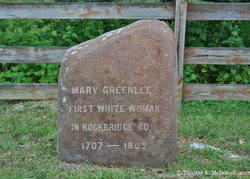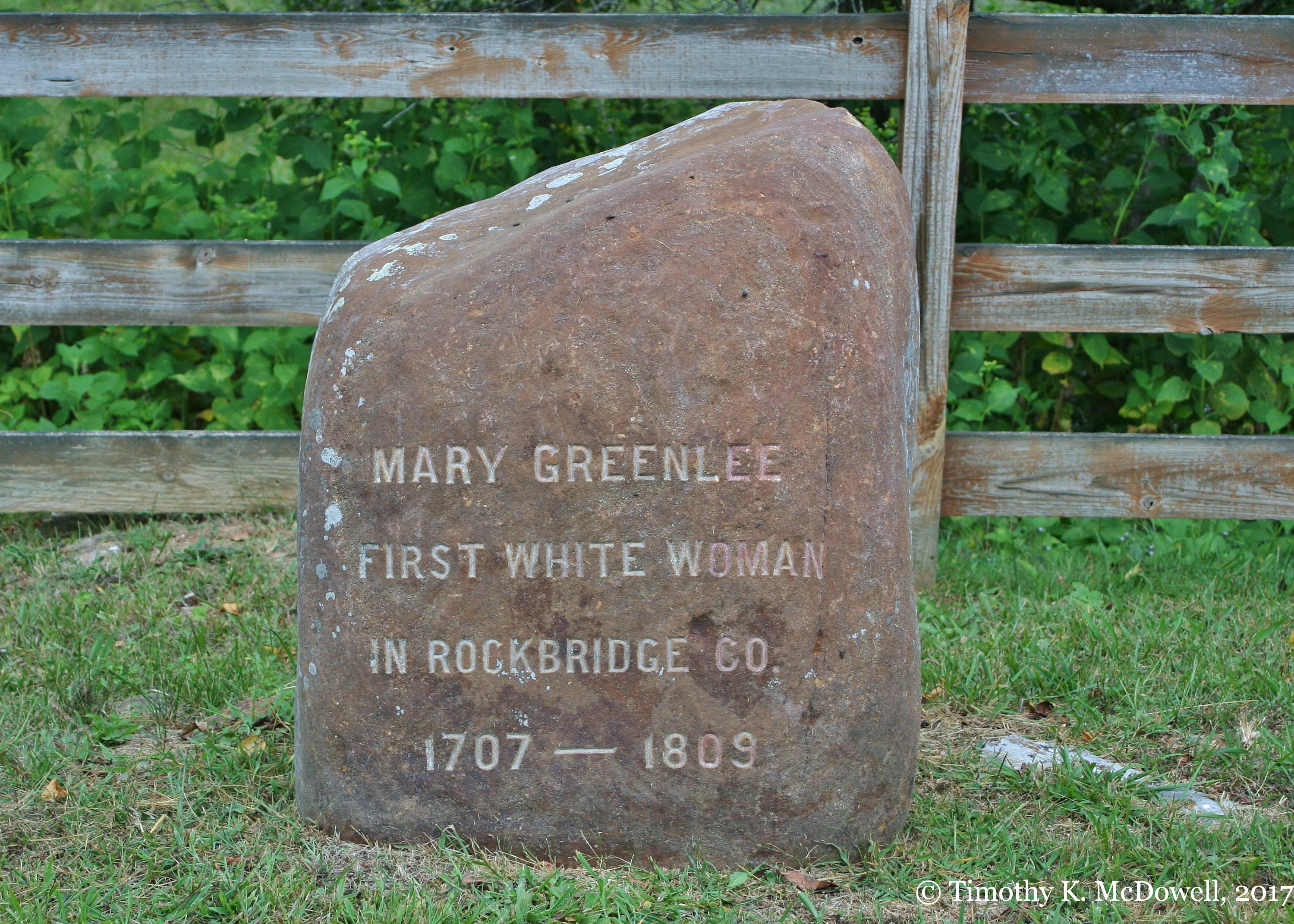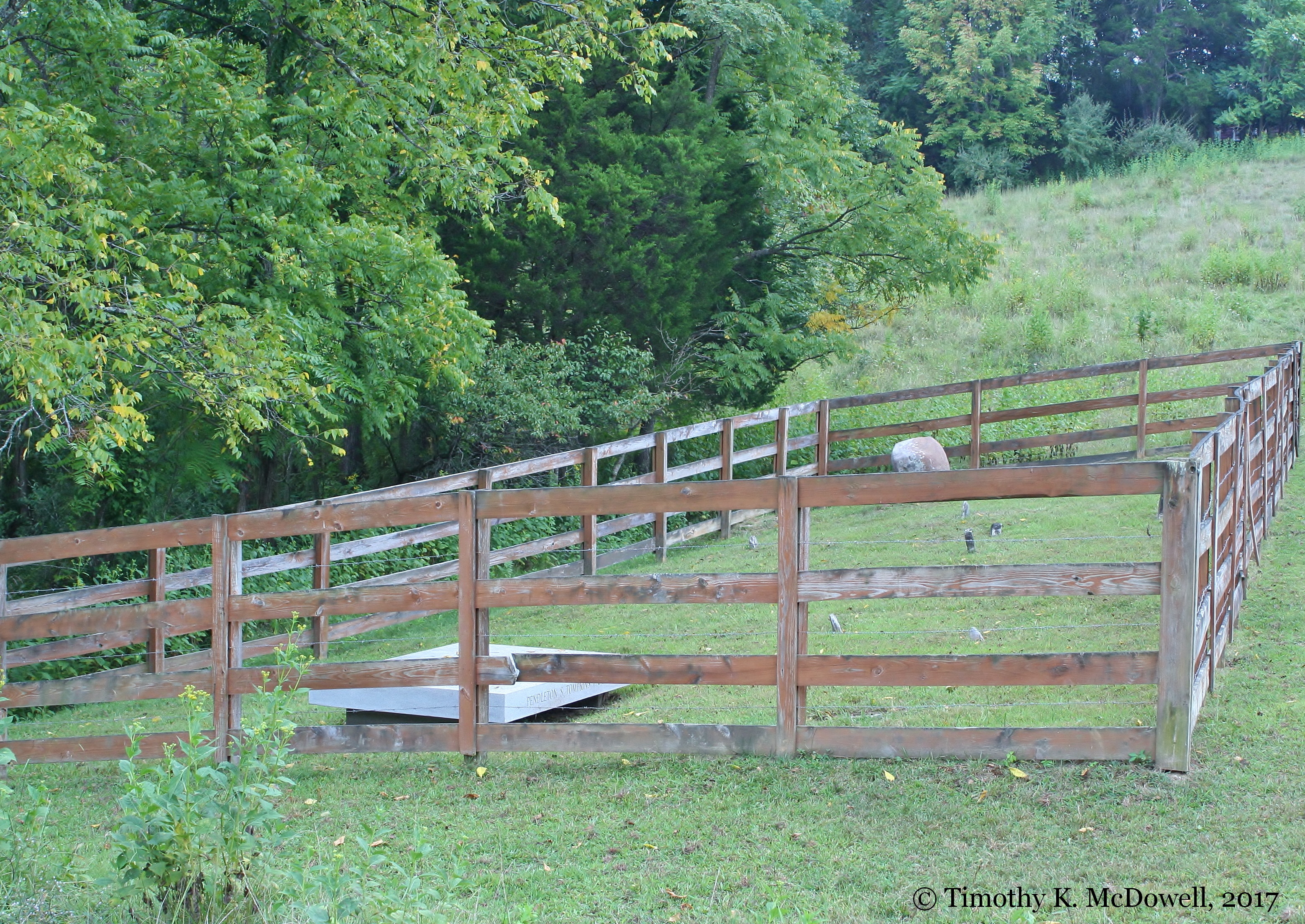Jane/abt. 1735
John/4 Oct 1738
James/19 Oct 1740
Samuel/4 Apr 1743
Mary/5 May 1745
Margaret/15 Jun 1748
Grace/23 Jun 1750
David/1 Nov 1752
Samuel/17 Jan 1757
Mary Elizabeth McDowell-Greenlee (1707 - 1809):
Mary Elizabeth Greenlee was the first white woman settler in what is now known as Rockbridge County, Virginia. She was born in Ireland in 1707, and grew up there. In 1729, Mary along with her husband James Greenlee, her father Ephriam McDowell, and her brothers, John and James McDowell, crossed the Atlantic Ocean and came to America. They settled near Philadelphia, Pennsylvania for several years. Soon they heard of a Scotch-Irish settlement headed by John Lewis, and decided to move to the wilds of Virginia. In 1737, the McDowell and Greenlee families, and perhaps a few others, made the long packhorse trip to Virginia. During their long journey, they met up with a man named Benjamin Borden. Mr. Borden had a large amount of land just south of Lewis' settlement. The Greenlees and McDowells soon decided to settle in Borden's Grant.
Mary Greenlee was a feisty lady and some people thought she was a witch. The Indians thought she was crazy. They believed bad things would happen to them if they harmed a crazy person and Mary was allowed to freely roam in and out of their camps. Mary probably was not crazy, but was actually very smart, although somewhat eccentric. She probably understood some of the Indians' superstitions and used them to her advantage. By letting them think she was crazy, she was not in any danger from them. In Mary Greenlee's time, people believed witches were about in great force. They believed these witches signed contracts with the devil in their own blood. They also believed witches had great powers which were used for evil doings. Once at a quilting party, Mary urged one of the guests to eat more saying, "The mare that does double work should be best fed." This comment was taken by the other ladies to mean that Mary was a witch. The lady she urged to eat was turned into a horse at night and ridden on Mary's haunts. Some of the stock of Mr. Craig of Triple Forks mysteriously disappeared. As Mary Greenlee was believed to be a witch, she was blamed for the loss. Other such accusations apparently abounded regarding Mary Greenlee; however, no evidence has been found which indicates she was ever tried as a witch. Once, when Alice Lewis, a young daughter of John and Margaret (Lynn) Lewis, was captured by the natives, Mary went into the Indian camps and rescued her. In her later years, Justices of the Peace visited Mary. There were many disputes about land ownership and Mary had been in the Rockbridge with the first group of settlers. On November 10, 1806, at the age of 99, Mary told the Justices of the Peace just who owned certain tracts of land in Borden's Grant in the 1730's and 1740's. This deposition was given in case of Joseph Burden, vs. Alex Culton and others. This not only helped settle the disputes, but also left a good record of some of the earliest settlers of Rockbridge.
In this deposition, Mary stated she and her husband James Greenlee settled in Borden's Grant in the fall of 1737. She stated that she, her husband, father and brothers, were intending to settle in Beverly Manor, but met up with Benjamin Borden while enroute and decided move onto his lands. She also stated her brother James had raised a crop of corn in Beverly Manor the year before they settled in Borden's Grant. Mary said John Lewis was related to her father.
Mary left to historians the story of the Millhollen girl who was a servant of Joseph Bell. Ms. Millhollen dressed herself in mens clothes, built five or six small cabins, and reserved the cabin rights in the name of Millhollen, using various first names for each cabin right. Any cabins erected entitled the builder to 100 acres of land, and the right to purchase a larger quantity at fifty shillings per one hundred acres.
Mary's deposition named many early settlers. Among other things, she noted Alex Miller was the first blacksmith to locate in Borden's Grant. John Hays built the first mill in Borden's Grant, very soon after the area was settled. She named many of the settlers and how they came to acquire title to their lands.
When Mary first came to the Borden Grant, she and her husband built their first cabin near a spring very close to present-day Fairfield. They sold this after a while and bought land from her brother James McDowell. On this land, Mary and James ran a tavern near Timber Ridge. James died about 1763, and Mary ran the tavern for another 17 years. In 1780, Mary moved near Natural Bridge to live with her son. She helped him run a ferry across the James River; Mary lived near Natural Bridge until her death in 1809, at age 102. She was buried on her son's farm, now (1994) owned by Sallie (Locher) Letcher.
Mary Greenlee has often been called "The Mother of Rockbridge County." She is an important personality to the local history of Rockbridge. Written by Angela M. Ruley and appears in The Rockbridge County, Virginia Heritage Book 1778-1997.
***The Mary Greenlee Monument was erected by APVA September 1944 and the following is inscribed on the stone:***
MARY GREENLEE
FIRST WHITE WOMAN
IN ROCKBRIDGE CO.
1707 - 1809
Cheryl Smith-Owens Family Papers
Jane/abt. 1735
John/4 Oct 1738
James/19 Oct 1740
Samuel/4 Apr 1743
Mary/5 May 1745
Margaret/15 Jun 1748
Grace/23 Jun 1750
David/1 Nov 1752
Samuel/17 Jan 1757
Mary Elizabeth McDowell-Greenlee (1707 - 1809):
Mary Elizabeth Greenlee was the first white woman settler in what is now known as Rockbridge County, Virginia. She was born in Ireland in 1707, and grew up there. In 1729, Mary along with her husband James Greenlee, her father Ephriam McDowell, and her brothers, John and James McDowell, crossed the Atlantic Ocean and came to America. They settled near Philadelphia, Pennsylvania for several years. Soon they heard of a Scotch-Irish settlement headed by John Lewis, and decided to move to the wilds of Virginia. In 1737, the McDowell and Greenlee families, and perhaps a few others, made the long packhorse trip to Virginia. During their long journey, they met up with a man named Benjamin Borden. Mr. Borden had a large amount of land just south of Lewis' settlement. The Greenlees and McDowells soon decided to settle in Borden's Grant.
Mary Greenlee was a feisty lady and some people thought she was a witch. The Indians thought she was crazy. They believed bad things would happen to them if they harmed a crazy person and Mary was allowed to freely roam in and out of their camps. Mary probably was not crazy, but was actually very smart, although somewhat eccentric. She probably understood some of the Indians' superstitions and used them to her advantage. By letting them think she was crazy, she was not in any danger from them. In Mary Greenlee's time, people believed witches were about in great force. They believed these witches signed contracts with the devil in their own blood. They also believed witches had great powers which were used for evil doings. Once at a quilting party, Mary urged one of the guests to eat more saying, "The mare that does double work should be best fed." This comment was taken by the other ladies to mean that Mary was a witch. The lady she urged to eat was turned into a horse at night and ridden on Mary's haunts. Some of the stock of Mr. Craig of Triple Forks mysteriously disappeared. As Mary Greenlee was believed to be a witch, she was blamed for the loss. Other such accusations apparently abounded regarding Mary Greenlee; however, no evidence has been found which indicates she was ever tried as a witch. Once, when Alice Lewis, a young daughter of John and Margaret (Lynn) Lewis, was captured by the natives, Mary went into the Indian camps and rescued her. In her later years, Justices of the Peace visited Mary. There were many disputes about land ownership and Mary had been in the Rockbridge with the first group of settlers. On November 10, 1806, at the age of 99, Mary told the Justices of the Peace just who owned certain tracts of land in Borden's Grant in the 1730's and 1740's. This deposition was given in case of Joseph Burden, vs. Alex Culton and others. This not only helped settle the disputes, but also left a good record of some of the earliest settlers of Rockbridge.
In this deposition, Mary stated she and her husband James Greenlee settled in Borden's Grant in the fall of 1737. She stated that she, her husband, father and brothers, were intending to settle in Beverly Manor, but met up with Benjamin Borden while enroute and decided move onto his lands. She also stated her brother James had raised a crop of corn in Beverly Manor the year before they settled in Borden's Grant. Mary said John Lewis was related to her father.
Mary left to historians the story of the Millhollen girl who was a servant of Joseph Bell. Ms. Millhollen dressed herself in mens clothes, built five or six small cabins, and reserved the cabin rights in the name of Millhollen, using various first names for each cabin right. Any cabins erected entitled the builder to 100 acres of land, and the right to purchase a larger quantity at fifty shillings per one hundred acres.
Mary's deposition named many early settlers. Among other things, she noted Alex Miller was the first blacksmith to locate in Borden's Grant. John Hays built the first mill in Borden's Grant, very soon after the area was settled. She named many of the settlers and how they came to acquire title to their lands.
When Mary first came to the Borden Grant, she and her husband built their first cabin near a spring very close to present-day Fairfield. They sold this after a while and bought land from her brother James McDowell. On this land, Mary and James ran a tavern near Timber Ridge. James died about 1763, and Mary ran the tavern for another 17 years. In 1780, Mary moved near Natural Bridge to live with her son. She helped him run a ferry across the James River; Mary lived near Natural Bridge until her death in 1809, at age 102. She was buried on her son's farm, now (1994) owned by Sallie (Locher) Letcher.
Mary Greenlee has often been called "The Mother of Rockbridge County." She is an important personality to the local history of Rockbridge. Written by Angela M. Ruley and appears in The Rockbridge County, Virginia Heritage Book 1778-1997.
***The Mary Greenlee Monument was erected by APVA September 1944 and the following is inscribed on the stone:***
MARY GREENLEE
FIRST WHITE WOMAN
IN ROCKBRIDGE CO.
1707 - 1809
Cheryl Smith-Owens Family Papers
Family Members
Advertisement
Explore more
Sponsored by Ancestry
Advertisement










